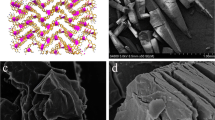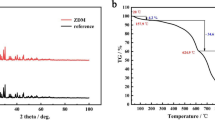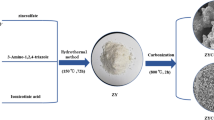Abstract
Nitrogen atom doping has been found to enhance the electrochemical performance of porous carbon (PC). In this study, hollow tubular nitrogen-doped porous carbon (N/PC) was synthesized using polyvinylpyrrolidone as the carbon–nitrogen source and fibrous brucite as the template through carbonization. The effects of nitrogen and argon protective atmospheres on the nitrogen content, the specific surface area (SSA), and electrochemical properties of N/PC were investigated. The results showed that compared with N/FBC-Ar, N/FBC-N2 prepared in nitrogen protective atmosphere had a higher nitrogen content and a larger proportion of pyrrolic nitrogen (N-5) and pyridinic nitrogen (N-6). N/FBC-N2 displayed a specific capacitance (C) of 194.1 F·g−1 at 1 A·g−1, greater than that of N/FBC-Ar (174.3 F·g−1). This work reveals that the nitrogen doping with a higher nitrogen content in nitrogen protective atmosphere is more favorable. Furthermore, a larger proportion of pyrrolic nitrogen and pyridinic nitrogen in the doped nitrogen atoms significantly enhances the electrochemical performance.
Similar content being viewed by others
References
Hou Z, Yu J, Zhou X, et al. Enhanced performance of hybrid supercapacitors by the synergistic effect of Co(OH)2 nanosheets and NiMn layered hydroxides. Journal of Colloid and Interface Science, 2023, 646: 753–762
Yan Y, Liu J, Huang K, et al. A fast micro-nano liquid layer induced construction of scaled-up oxyhydroxide based electrocatalysts for alkaline water splitting. Journal of Materials Chemistry A: Materials for Energy and Sustainability, 2021, 9(47): 26777–26787
Zhang H, Liu X, Chen Y, et al. Construction of core-shell heterostructure containing sandwich-like nanoarray for high-performance supercapacitors. Journal of Energy Storage, 2023, 67: 107647
Akshay M, Jayaraman S, Ulaganathan M, et al. Interphase stabilized electrospun SnO2 fibers as alloy anode via restricted cycling for Li-ion capacitors with high energy and wide temperature operation. Journal of Colloid and Interface Science, 2023, 646: 703–710
Krishna B N V, Ankinapalli O R, Reddy A R, et al. Facile one-step hydrothermal route to MSe/Mo3Se4 (M: Zn, Mn, and Ni)-based electrode materials for ultralong-life hybrid supercapacitors. Journal of Materials Science and Technology, 2023, 156: 230–240
Wan X, Mu T, Yin G. Intrinsic self-healing chemistry for next-generation flexible energy storage devices. Nano-Micro Letters, 2023, 15(1): 99
Lu X F, Fang Y, Luan D, et al. Metal–organic frameworks derived functional materials for electrochemical energy storage and conversion: a mini review. Nano Letters, 2021, 21(4): 1555–1565
Kuang H, Zhang H, Liu X, et al. Microwave-assisted synthesis of NiCo-LDH/graphene nanoscrolls composite for supercapacitor. Carbon, 2022, 190: 57–67
Wang Z, Zhao K, Wang L, et al. Hierarchical and core–shell structured CuCo2O4@NiMn-LDH composites as supercapacitor electrode materials with high specific capacitance. Journal of Energy Storage, 2023, 67: 107327
Xiao G, Ju J, Li M, et al. Weavable yarn-shaped supercapacitor in sweat-activated self-charging power textile for wireless sweat biosensing. Biosensors & Bioelectronics, 2023, 235: 115389
Seenivasan S, Shim K I, Lim C, et al. Boosting pseudocapacitive behavior of supercapattery electrodes by incorporating a schottky junction for ultrahigh energy density. Nano-Micro Letters, 2023, 15(1): 62
Hong W L, Lin L Y. Studying the substrate effects on energy storage abilities of flexible battery supercapacitor hybrids based on nickel cobalt oxide and nickel cobalt oxide@nickel molybdenum oxide. Electrochimica Acta, 2019, 308: 83–90
Zhang W, Li W, Li S. Molten salt assisted self-activated carbon with controllable architecture for aqueous supercapacitor. Journal of Materials Science and Technology, 2023, 156: 107–117
Guo T, Liu Y, Xu G, et al. Three-dimensional honeycomb-like hierarchically structured carbon nanosheets from resin for high-performance supercapacitors. New Journal of Chemistry, 2023, 47(25): 11996–12006
Wang Q, Chen Z, Luo Q, et al. Capillary evaporation on high-dense conductive ramie carbon for assisting highly volumetric-performance supercapacitors. Small, 2023, 20: 2303349
Wu Z, Chen Q, Li C, et al. Hydrogel-derived nitrogen-doped porous carbon framework with vanadium nitride decoration for supercapacitors with superior cycling performance. Journal of Materials Science and Technology, 2023, 155: 167–174
Zhang W, Liu B, Yang M, et al. Biowaste derived porous carbon sponge for high performance supercapacitors. Journal of Materials Science and Technology, 2021, 95: 105–113
Song Z, Miao L, Ruhlmann L, et al. Lewis pair interaction self-assembly of carbon superstructures harvesting high-energy and ultralong-life zinc-ion storage. Advanced Functional Materials, 2022, 32(48): 2208049
Dong J, Zeng J, Li J, et al. Sustainable and scalable synthesis of 2D ultrathin hierarchical porous carbon nanosheets for high-performance supercapacitor. Small, 2023, 19(40): 2301353
Poornima B H, Vijayakumar T. Hydrothermal synthesis of boron-doped porous carbon from azadirachta Indica wood for supercapacitor application. Inorganic Chemistry Communications, 2022, 145: 109953
Qin Y, Song Z, Miao L, et al. Hydrogen-bond-mediated micelle aggregating self-assembly towards carbon nanofiber networks for high-energy and long-life zinc ion capacitors. Chemical Engineering Journal, 2023, 470: 144256
Zhang Y, Song Z, Miao L, et al. All-round enhancement in Zn-ion storage enabled by solvent-guided Lewis acid-base self-assembly of heterodiatomic carbon nanotubes. ACS Applied Materials & Interfaces, 2023, 15(29): 35380–35390
Yeganeh Ghotbi M, Javanmard A, Soleimani H. Layered nanoreactor assisted to produce B-doped and P-doped 3D carbon nanostructures for supercapacitor electrodes. Journal of Energy Storage, 2021, 44: 103514
Liu F, Chuan X, Yang Y, et al. Influence of N/S co-doping on electrochemical property of brucite template carbon nanotubes. Journal of Inorganic Materials, 2021, 36(7): 711–717
Yang L, He X, Wei Y, et al. Interconnected N/P co-doped carbon nanocage as high capacitance electrode material for energy storage devices. Nano Research, 2022, 15(5): 4068–4075
Wang T, Wu D, Yuan F, et al. Chitosan derived porous carbon prepared by amino acid proton salt for high-performance quasistate-solid supercapacitor. Chemical Engineering Journal, 2023, 462: 142292
Liu F, Chuan X, Li B, et al. One-step carbonization synthesis of in-situ nitrogen-doped carbon tubes using fibrous brucite as the template for supercapacitors. Materials Chemistry and Physics, 2022, 281: 125811
Liu F, Niu J, Chuan X, et al. Nitrogen and sulfur co-doping carbon in different dimensions as electrode for supercapacitor applications. Journal of Alloys and Compounds, 2023, 947: 169654
Yuan Y. Preparation of nitrogen doped carbon materials and analysis of their electrochemical performance. International Journal of Electrochemical Science, 2022, 17(8): 220825
Wu H, Du J, Chen A. N-doped hollow porous carbon nanotubes derived from in situ activation approach for supercapacitor. Journal of Materials Science, 2023, 58(12): 5362–5371
Bejjanki D, Banothu P, Kumar V B, et al. Biomass-derived N-doped activated carbon from eucalyptus leaves as an efficient supercapacitor slectrode material. Journal of Carbon Research, 2023, 9(1): 24
Wang D W, Li F, Liu M, et al. 3D aperiodic hierarchical porous graphitic carbon material for high-rate electrochemical capacitive energy storage. Angewandte Chemie International Edition, 2008, 47(2): 373–376
Wu M, Ai P, Tan M, et al. Synthesis of starch-derived mesoporous carbon for electric double layer capacitor. Chemical Engineering Journal, 2014, 245: 166–172
Qiu S, Chen Z, Zhuo H, et al. Using FeCl3 as a solvent, template, and activator to prepare B, N co-doping porous carbon with excellent supercapacitance. ACS Sustainable Chemistry & Engineering, 2019, 7(19): 15983–15994
Zhang Y, Liu L, Zhang L, et al. Template-free method for fabricating carbon nanotube combined with thin N-doped porous carbon composite for supercapacitor. Journal of Materials Science, 2019, 54(8): 6451–6460
Liu Y, Xiang C, Chu H, et al. Binary Co-Ni oxide nanoparticle-loaded hierarchical graphitic porous carbon for high-performance supercapacitors. Journal of Materials Science and Technology, 2020, 37: 135–142
Wang M, Zhai D D, Liu H, et al. Design and synthesis of highly N, S co-doped 3D carbon materials with tunable porosity for supercapacitors. Ionics, 2020, 26(4): 2031–2041
Sing K S W. Reporting physisorption data for gas/solid systems with special reference to the determination of surface area and porosity (Recommendations 1984). Pure and Applied Chemistry, 1985, 57(4): 603–619
Liu T, Zhang F, Song Y, et al. Revitalizing carbon supercapacitor electrodes with hierarchical porous structures. Journal of Materials Chemistry A: Materials for Energy and Sustainability, 2017, 5(34): 17705–17733
Zhang A, Teng F, Zhang Q, et al. Boosted electrochemistry properties of Cu4[(OH)0.29Cl0.71](OH)6 hexagonal prisms by 3D-cage atomic configuration of (1 0 0) facet. Applied Surface Science, 2018, 428: 586–592
Zheng C, Hu X, Sun X, et al. Large-scale synthesis of nitrogen-rich hierarchically porous carbon as anode for lithium-ion batteries with high capacity and rate capability. Electrochimica Acta, 2019, 306: 339–349
Miao L, Zhu D, Liu M, et al. N, S co-doped hierarchical porous carbon rods derived from protic salt: facile synthesis for high energy density supercapacitors. Electrochimica Acta, 2018, 274: 378–388
Yuan F, Shi C, Li Q, et al. Unraveling the effect of intrinsic carbon defects on potassium storage performance. Advanced Functional Materials, 2022, 32(48): 2208966
Arrigo R, Hävecker M, Wrabetz S, et al. Tuning the acid/base properties of nanocarbons by functionalization via amination. Journal of the American Chemical Society, 2010, 132(28): 9616–9630
Chen M, Huang Q, Zhang Q, et al. Annealing a graphene oxide film to produce a free standing high conductive graphene film. Carbon, 2012, 50(2): 659–667
Liu B, Liu Y, Chen H, et al. Oxygen and nitrogen co-doped porous carbon nanosheets derived from Perilla frutescens for high volumetric performance supercapacitors. Journal of Power Sources, 2017, 341: 309–317
Hulicova-Jurcakova D, Seredych M, Lu G Q, et al. Combined effect of nitrogen- and oxygen-containing functional groups of microporous activated carbon on its electrochemical performance in supercapacitors. Advanced Functional Materials, 2009, 19(3): 438–447
Zhu W, Wang H, Zhao R, et al. In situ fabrication of nitrogen doped porous carbon nanorods derived from metal-organic frameworks and its application as supercapacitor electrodes. Journal of Solid State Chemistry, 2019, 277: 100–106
Zhang S, Shi X, Wen X, et al. Interconnected nanoporous carbon structure delivering enhanced mass transport and conductivity toward exceptional performance in supercapacitor. Journal of Power Sources, 2019, 435: 226811
Li L X, Tao J, Geng X, et al. Preparation and supercapacitor performance of nitrogen-doped carbon nanotubes from polyaniline modification. Acta Physico-Chimica Sinica, 2013, 29(1): 111–116 (in Chinese)
Mofokeng T P, Tetana Z N, Ozoemena K I. Defective 3D nitrogen-doped carbon nanotube-carbon fibre networks for high-performance supercapacitor: transformative role of nitrogen-doping from surface-confined to diffusive kinetics. Carbon, 2020, 169: 312–326
Mashayekhi A, Hosseini S M, Amiri M H, et al. Plasma-assisted nitrogen doping of VACNTs for efficiently enhancing the supercapacitor performance. Journal of Nanoparticle Research, 2016, 18(6): 154
Gueon D, Moon J H. Nitrogen-doped carbon nanotube spherical particles for supercapacitor applications: emulsion-assisted compact packing and capacitance enhancement. ACS Applied Materials & Interfaces, 2015, 7(36): 20083–20089
Kuok F H, Chien H H, Lee C C, et al. Atmospheric-pressure-plasma-jet processed carbon nanotube (CNT)–reduced graphene oxide (rGO) nanocomposites for gel-electrolyte supercapacitors. RSC Advances, 2018, 8(6): 2851–2857
Liu L, Guo R, Zhang X, et al. Preparation and electrochemical performance of nitrogen-doped multi-walled carbon nanotubes. Powder Technology, 2018, 42: 662–664
Lobiak E V, Bulusheva L G, Fedorovskaya E O, et al. One-step chemical vapor deposition synthesis and supercapacitor performance of nitrogen-doped porous carbon-carbon nanotube hybrids. Beilstein Journal of Nanotechnology, 2017, 8: 2669–2679
John A R, Arumugam P. Open ended nitrogen-doped carbon nanotubes for the electrochemical storage of energy in a supercapacitor electrode. Journal of Power Sources, 2015, 277: 387–392
Liang M, Zhao M, Wang H, et al. Enhanced cycling stability of hierarchical NiCo2S4@Ni(OH)2@PPy core-shell nanotube arrays for aqueous asymmetric supercapacitors. Journal of Materials Chemistry A: Materials for Energy and Sustainability, 2018, 6(6): 2482–2493
Acknowledgements
The authors would like to acknowledge the support from the National Natural Science Foundation of China (Grant Nos. 51774016 and 52074015), Clinical Medicine Plus X - Young Scholars Project, Peking University (2022–33; 2023–45), the Fundamental Research Funds for the Central Universities (China), the Fundamental Research Funds for the Central Universities (2019XKQYMS76), and the Central University Basic Research Business Fund (2023QN1038). We also express gratitude to Associate Professor Kai Chen’s team for their contact angle measurement instrument and Professor Peizhong Feng’s team for the Chenhua electrochemical workstation.
Author information
Authors and Affiliations
Corresponding authors
Ethics declarations
Declaration of competing interests The authors declare that they have no competing interests.
Electronic Supplementary Material
Rights and permissions
About this article
Cite this article
Liu, F., Niu, J., Chuan, X. et al. Effect of carbonization atmosphere on electrochemical properties of nitrogen-doped porous carbon. Front. Mater. Sci. 17, 230669 (2023). https://doi.org/10.1007/s11706-023-0669-1
Received:
Accepted:
Published:
DOI: https://doi.org/10.1007/s11706-023-0669-1




